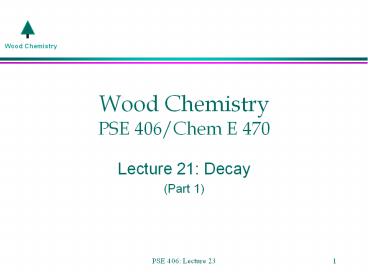Wood Chemistry PSE 406/Chem E 470 - PowerPoint PPT Presentation
1 / 14
Title:
Wood Chemistry PSE 406/Chem E 470
Description:
PSE 406/Chem E 470 Lecture 21: Decay (Part 1) Introduction to Deterioration Plant matter is constantly under attack by fungi, insects, bacteria, marine borers and the ... – PowerPoint PPT presentation
Number of Views:207
Avg rating:3.0/5.0
Title: Wood Chemistry PSE 406/Chem E 470
1
Wood ChemistryPSE 406/Chem E 470
- Lecture 21 Decay
- (Part 1)
2
Introduction to Deterioration
- Plant matter is constantly under attack by fungi,
insects, bacteria, marine borers and the weather. - It is estimated that roughly 1/10 of the forest
products generated each year are destroyed. - While this can be bad, without these processes we
would be buried in a sea of old dead plant matter.
3
PSE 406 Emphasis
- While weathering, insects and marine borers cause
substantial damage, we are going to focus on
decay caused by fungi and bacteria. - In particular, we are going to discuss some of
the biology involved but mostly the chemistry.
4
Fungi
- The wood deteriorating fungi are organized into
three groups - White rot fungi
- Brown rot fungi
- Soft rot fungi
- This image shows fungal fruiting bodies
(sporophores). - These are structures that release the
reproductive spores. The fungi are actually
inside the tree.
5
White Rot Fungi
- This group of organisms is known as white rot
because of their ability to degrade lignin. - The decaying wood looks white.
- Cellulose and hemicelluloses are also degraded.
- Largest number of species belong to
Basidiomycotina - Xyariaceous and Diatrypacsous also numerous.
- White rot fungi typically decay hardwoods
- They will decay softwoods but hardwoods are their
food of choice. - Simultaneous decay All the cell components are
degraded simultaneously from lumen outwards. - Preferential decay Lignin and hemicelluloses are
removed selectively across the cell wall leaving
cellulose.
6
Brown Rot Fungi
- With brown rot fungi, cellulose and
hemicelluloses are degraded with only limited
lignin degradation. - Decayed wood is brown and crumbly.
- Most species belong to Basidiomycotina.
- Brown rot fungi typically decay softwoods.
- Attack starts at the cell lumen and works
outwards. - Cellulose is rapidly degraded.
7
Soft Rot Fungi
- Soft rot occurs in areas where plant matter is in
contact with excessive amounts of moisture. - The term soft rots comes from the soft appearance
of the decayed surface. - When dry the wood surface is cracked.
- Members Ascomycetes and Fungi Imperfect.
- Degradation is mainly though cavity formation in
the secondary wall. - Soft rot fungi attack holocellulose lignin
protects the plant.
8
Molds and Blue Stain Fungi
- Wood is often stained by these organisms with
little loss of structural integrity. - Particularly in softwoods, some strength loss in
hardwoods. - Molds Aspergillus, Penicillium etc.
- Blue Stain Fungi Philaphora, etc.
- These organisms typically attack non lignified
parenchyma cells and pit membranes.
9
Bacteria
- Two forms of attack
- Degradation of pit membranes and parenchyma cells
leading to increased permeability. - Aerobic and anaerobic
- Typically a problem when wood stored in ponds.
- Cell wall degradation
- This type is typically aerobic
- Can attack both lignin and holocellulose although
typically lignin more difficult to deal with. - Does not compete well against fungi so needs some
condition to thrive ie reduced oxygen, etc,
10
What do Fungi Need?
- Favorable temperature
- Fungi do not like cold
- Oxygen
- Water storage suffocates them.
- Moisture
- They need moisture but see above bullet.
- Adequate food supply including nitrogen.
11
How Does This Happen?
- This is a picture of highly degraded wood.
- What you see are the fungal bodies known as
hyphae. They grow through the plant matter like
little worms. - The organisms arrive as spores (transported by a
variety of methods.
12
Movement of Hyphae
- This SEM picture shows fungal hyphae inside
hardwood xylem. - The hyphae enter the cells though openings (pits,
etc) or can bore directly through the wall
(chemically)
13
How Do Fungi Destroy the Cell Wall Material?
- This is a very complex question which is not well
understood. - The process is enzymatic. Fungi possess a wide
variety of cell wall degrading enzymes - Cellulases, hemicellulases, etc.
14
How do Enzymes Function?
- Enzymes are very very large proteins.
- Enzymes have very specific functions they cause
chemical reactions to occur in exact fashions. - A very large number of enzymes have been isolated
from fungi and their functions identified. - Fungal hyphae release enzymes to degrade cell
wall components this reaction is extra cellular - Enzymes are too large to penetrate into the cell
wall structure and react with cell wall
components. How does degradation occur? - This is the big unknown question.































